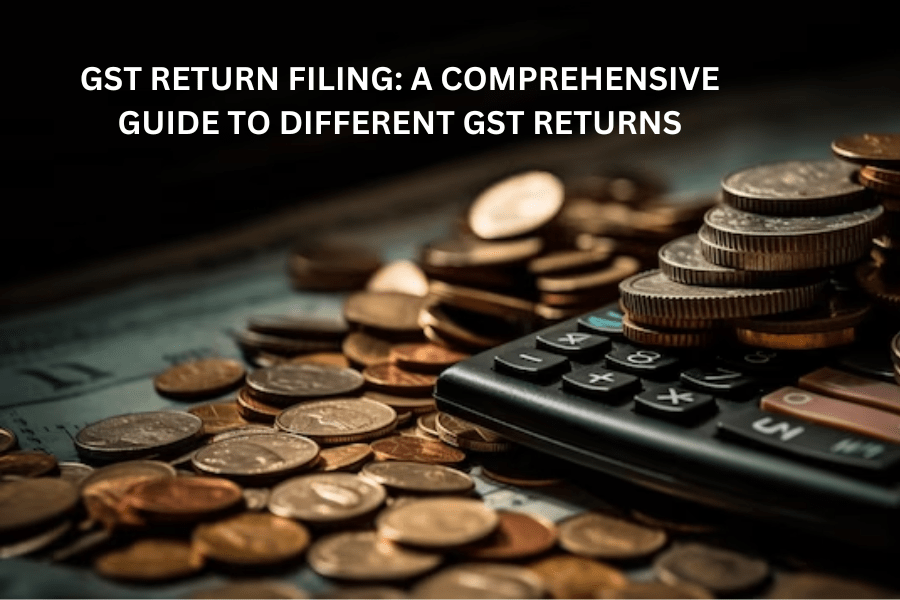Goods and Services Tax (GST) is a tax levied on the supply of goods and services in India. GST was introduced to unify multiple taxes and make the tax system more efficient and streamlined. Every registered taxpayer in India has to file a GST return, which is a document that contains details of all sales, purchases, and tax paid on them. In this article, we will discuss the different types of GST returns and the process of GST return filing.
Types of GST Returns
There are various types of GST returns that taxpayers need to file depending on their business operations. Let’s have a look at the different types of GST returns:
GSTR-1: Outward Supplies
GSTR-1 is a monthly or quarterly return filed by all registered taxpayers who have a turnover of more than Rs. 1.5 crores in the previous financial year. GSTR-1 contains details of all outward supplies of goods and services made during the month, including details of the recipient, the value of supplies, and the tax collected.
GSTR-2A: Inward Supplies
GSTR-2A is a return that is automatically generated based on the information filed in the GSTR-1 by the supplier. It contains details of all inward supplies of goods and services received during the month, including details of the supplier, the value of supplies, and the tax paid.
GSTR-3B: Summary Return
GSTR-3B is a monthly return filed by all registered taxpayers. It contains a summary of all outward and inward supplies made during the month, the total tax liability, the tax paid, and the input tax credit claimed.
GSTR-4: Composition Scheme Return
GSTR-4 is a quarterly return filed by taxpayers who have opted for the composition scheme. Under the composition scheme, taxpayers with a turnover of up to Rs. 1.5 crores can pay a fixed percentage of their turnover as tax instead of the regular GST rates. GSTR-4 contains details of all supplies made during the quarter, the tax paid, and the input tax credit claimed.
GSTR-5: Non-Resident Foreign Taxpayer Return
GSTR-5 is a return filed by non-resident taxpayers who are registered under GST and have no business operations in India but have supplied goods and services in India. GSTR-5 contains details of all supplies made during the month, the tax paid, and the input tax credit claimed.
GSTR-6: Input Service Distributor Return
GSTR-6 is a return filed by Input Service Distributors (ISDs) who distribute the input tax credit to their branches or units. GSTR-6 contains details of all input tax credit received and distributed during the month.
GSTR-7: Tax Deducted at Source (TDS) Return
GSTR-7 is a return filed by taxpayers who deduct tax at source from the payment made to the supplier. It contains details of all supplies made during the month, the tax deducted, and the tax paid.
GSTR-8: Tax Collected at Source (TCS) Return
GSTR-8 is a return filed by e-commerce operators who collect tax at source from the payment made to the supplier. It contains details of all supplies made during the month, the tax collected, and the tax paid.
GSTR-9: Annual Return
GSTR-9 is an annual return filed by all registered taxpayers. It contains details of all outward and inward supplies made during the financial year, the total tax liability, the tax paid, and the input tax credit claimed.
GSTR-10: Final Return
GSTR-10 is a final return filed by taxpayers who have cancelled their GST registration. It contains details of all outward and inward supplies made up to the date of cancellation, the total tax liability, the tax paid, and the input tax credit claimed.
Process of GST Return Filing
Now that we have discussed the different types of GST returns, let’s look at the process of GST return filing:
Step 1: Log in to the GST Portal
To file a GST return, the taxpayer needs to log in to the GST portal with their registered username and password.
Step 2: Select the Type of Return
Once logged in, the taxpayer needs to select the type of return they want to file. They can choose from the list of available returns based on their business operations.
Step 3: Enter the Details
The taxpayer needs to enter the details of all the outward and inward supplies made during the month, including details of the recipient, the value of supplies, and the tax collected or paid.
Step 4: Preview and Submit
After entering all the details, the taxpayer needs to preview the return and verify the correctness of the information. Once verified, the taxpayer can submit the return.
Step 5: Payment of Tax
After submitting the return, the taxpayer needs to pay the tax liability through the GST portal. The taxpayer can make the payment through the online payment modes available on the portal.
Step 6: Filing of Return
Once the tax liability is paid, the taxpayer needs to file the return by clicking on the “File Return” button on the portal. The GST return filing process is complete after this step.
Conclusion
GST return filing is a crucial aspect of GST compliance. It helps the government keep track of all the transactions made by the taxpayers and ensures that the tax system is efficient and streamlined. In this article, we discussed the different types of GST returns and the process of GST return filing. It is important for taxpayers to file their returns on time and ensure the correctness of the information provided to avoid penalties and fines.






